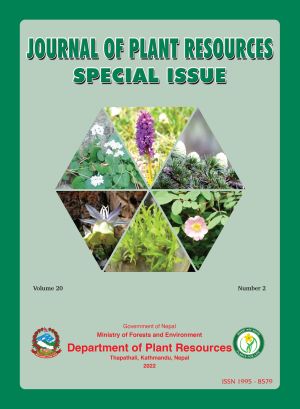DNA Barcoding of Dendrobium moschatum (Banks) Sw. Specimen from Makawanpur, Central Nepal
DOI:
https://doi.org/10.3126/bdpr.v20i2.57001Keywords:
Accessions, Dendrobium, Evolutionary tree, Molecular markers, PlastomeAbstract
The genus Dendrobium, with sparse distribution in nature, is one of the largest genera of Orchidaceae. DNA barcoding could be the best option for rapid and accurate identification of the Dendrobium species. The objective of the present study is to delineate the Dendrobium species using DNA barcoding technology. Here, we used a specimen of Dendrobium sp. collected from Brindaban Botanical Garden, Makawanpur (540 m asl) as a test object. We amplified and sequenced three chloroplast loci, rbcL (Ribulose-1,5- bisphosphate carboxylase), matK (Maturase K) and psbA-trnH (intergenic spacer) from the specimen. We retrieved twelve accessions of plastome sequences from NCBI, representing six Dendrobium species (D. candidum, D. crepidatum, D. chrysanthum, D. denneanum, D. fimbriatum and D. moschatum) reported in Nepal. Similarly, one accession of plastome of Bulbophyllum epiphytum was also retrieved, to be used as an out-group. Respective aligned sequences of rbcL, matK and psbA-trnH were extracted from each accession. Evolutionary analysis was performed following the Maximum Likelihood approach using MEGA X. The result showed that the evolutionary tree generated with combined sequences of all three loci (rbcL, matK and psbA-trnH) was better compared to that generated with sequence of single locus. However, additional markers are required for higher accuracy.




